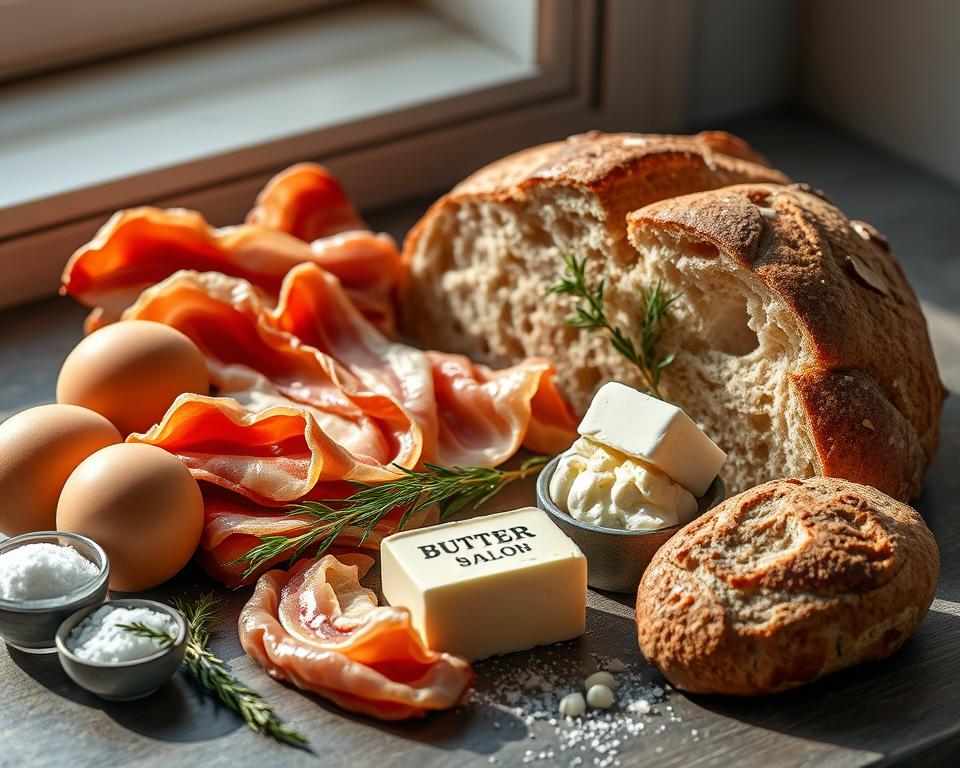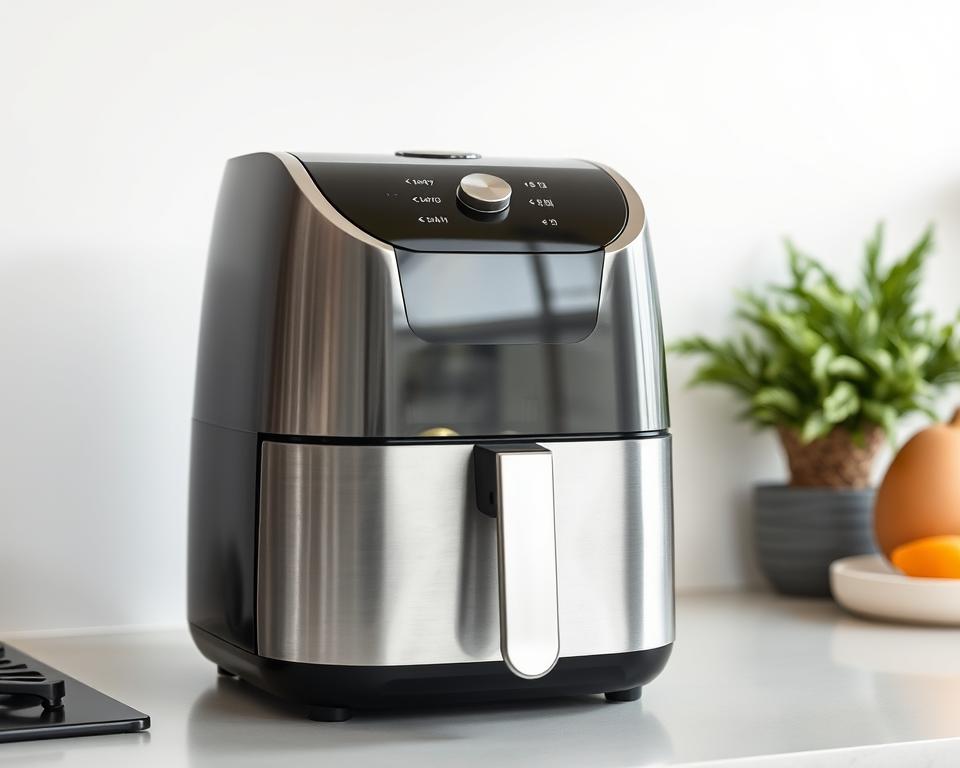I fell for the Homemade Scotch Egg Recipe the first time I cracked a golden shell and found a warm, still-runny yolk inside — soft, savoury, and utterly comforting.
I like to recreate that cosy pub moment at my kitchen table. I use higher-welfare sausages, fresh chives and parsley, a whisper of nutmeg and a good smear of English mustard for depth.
Simple steps, familiar ingredients and a few pro tips help you get a crisp coating and a steady centre. Boil eggs briefly for a runny middle, chill and wrap in seasoned sausage, then fry at the right oil temperature for a golden finish.
If you prefer lighter cooking, there are oven-bake and air-fryer options that keep the crunch but cut the oil. I’ll also share how to double-coat for extra crispness and when to finish in the oven if you worry about doneness.
Key Takeaways
- Use good-quality sausage and fresh herbs for true pub-style flavour.
- Boil eggs 3–4 minutes for a runny centre; cool in cold water to stop cooking.
- Fry at about 150ºC/300ºF until golden, or bake/air-fry as lighter alternatives.
- Double-coating in egg and breadcrumbs gives a crisper finish.
- Serve with Scottish Cheddar, pickles or piccalilli for a celebratory bite.
Why I love making scotch eggs at home
Travel taught me to treasure small comforts. I learned that pubs can make a simple snack feel like an event. So I started making scotch eggs in my own kitchen — to capture that warm, convivial pub moment without leaving home.
A classic British snack with a pub feel
I love how basic eggs and seasoned sausage turn into a shareable bundle of joy. The traditional scotch eggs version wraps peeled eggs in meat flavoured with herbs, mustard and nutmeg, then coats and cooks until golden.
My warm, simple approach to a traditional scotch
I keep the method calm and practical — simple shaping, even coating and the right cook times. That gives a crisp shell and a warm centre you can choose runny or firm.
- I fell for scotch eggs on chilly pub afternoons — hot, crisp and comforting.
- They are brilliant for picnics, parties or an easy supper; make ahead and slice to serve with pickles.
- Save the recipe if you love classic British dishes you can master at home.
| Method | Temp | Time | Finish |
|---|---|---|---|
| Deep-fry | 150ºC / 300ºF | Until golden (few minutes) | Very crisp, rich |
| Oven bake | 180ºC / 350ºF | 12–15 minutes | Less oily, crisp |
| Air fryer | 200ºC / 390ºF | About 12 minutes | Quick, even crunch |
Ingredients, tools and prep at a glance
A tidy prep station makes the cooking smoother — let’s get everything laid out first.

Core ingredients
- 8–10 eggs — boiled to your preferred centre and cooled in ice-cold water (eggs ×4).
- 500 g–1½ lb sausage meat or 8 sausages, finely chopped (sausage meat ×2).
- Plain flour (flour ×2), beaten egg, and fresh or panko breadcrumbs (breadcrumbs ×2).
- A pinch of salt and black pepper, fresh chives/parsley, English mustard and a little nutmeg.
Helpful kit and prep tips
Use three bowls — one for flour, one bowl for beaten eggs, one for breadcrumbs (bowls ×1; bowl ×1).
Have about 2 litres of vegetable oil if deep-frying, or a light oil spray for baking (oil ×1).
Bring a thermometer to check temperature — aim for about 350–360ºF for deep-fry confidence (temperature ×1; fryer ×1).
| Item | Why | Tip |
|---|---|---|
| Thermometer | Steady heat | Keep oil at 350–360ºF |
| Kitchen paper | Drain excess oil | Line a tray to rest cooked pieces (paper ×1; kitchen paper ×1) |
| Ice-cold water | Stops carryover cooking | Makes peeling easier (water ×1) |
Save the recipe to keep this checklist handy — a set station and simple swaps (fresh vs panko breadcrumbs) make the process friendly and calm.
Homemade Scotch Egg Recipe: step-by-step method
Let’s walk through the method step by step so you can go from boiling to biting with confidence. I keep things calm and practical — timing, a tidy station and a couple of small tricks make all the difference.
Boil, chill and peel
Boil the eggs 3–4 minutes for a soft centre, then plunge them into ice-cold water for about 5 minutes. For firmer yolks, add a couple of minutes to the boil.
Peel gently under a thin stream of water and set aside so each egg is dry before wrapping. Dry surfaces help the coating cling.
Season and wrap
Mix the sausage mixture with chopped herbs, English mustard and a light grate of nutmeg. Divide the mixture evenly.
Flour your hands, press meat into a thin patty, then work the portion around egg so thickness is even all over.
Coating station and frying
Set three bowls: flour, beaten egg, and breadcrumbs. Go flour → beaten egg → breadcrumbs, then repeat the egg and crumb for extra crunch.
Keep one hand for dry and one for wet to limit mess and improve adhesion. Heat oil to about 150ºC/300ºF and cook minutes until golden, turning gently.
Finish and tips for centres
Drain on kitchen paper for a few moments; finish briefly in a hot oven if you need to ensure the meat is cooked through.
Tip: For runny yolks stick to 3–4 minutes; for hard centres add a couple more minutes at the boil. Don’t forget to save recipe notes with the timing you prefer.
- Quick checklist: boil, chill, dry, wrap, flour, beaten egg, breadcrumbs, fry, drain.
| Stage | Time | Result |
|---|---|---|
| Soft centre boil | 3–4 minutes | Runny yolk |
| Frying | About 4 minutes | Golden, crisp coating |
| Chill in water | About 5 minutes | Easy to peel |
How to cook: deep-fried, baked or air fryer
Whether you crave deep-fry gloss or speedy air-fryer crunch, I’ll show timings, temps and small tricks that work in any kitchen.

Deep-fry
Heat oil slowly and check the temperature — aim around 350–360ºF for even browning and cooked sausage. For a gentler approach some cooks use about 150ºC/300ºF and fry for roughly 4 minutes until golden.
Lower each coated egg gently, turn once and drain on paper or kitchen paper to soak up excess oil. If you worry the centre needs a touch more time, finish in a hot oven for a few minutes.
Bake in the oven
For a lighter route, bake at 180ºC/350ºF for 25–30 minutes. Turn halfway and give a light oil spray so the coating still shatters when you bite.
This method keeps hands off and uses less oil while keeping the sausage cooked through and the exterior crisp.
Air fryer
Air fry at 200ºC/390ºF for about 12 minutes, turning halfway so the coating browns evenly. Cook in batches so air can circulate and each piece stays crisp.
Tip: you can soft-boil eggs in an air fryer at 130ºC/270ºF for 11 minutes, then plunge into cold water before wrapping.
- Why temp matters: too hot and the outside browns before the meat cooks; too cool and the coating soaks up oil.
- Smaller eggs need less time; larger ones a little more — watch colour and feel the coating.
- Try all three ways and save recipe notes so you know which method you prefer for weeknights or gatherings.
| Method | Temp | Minutes | Result |
|---|---|---|---|
| Deep-fry | 150ºC / 350–360ºF | 4 | Golden, pub-style crisp |
| Bake | 180ºC / 350ºF | 25–30 | Lighter, crunchy |
| Air fryer | 200ºC / 390ºF | 12 (turn halfway) | Quick, even crunch |
Serving ideas, swaps and flavour twists
A bright platter and a warm chutney make these bites feel like a proper pub-style dish at home. I often serve scotch eggs hot with English mustard and Branston pickle for a bold contrast.
If you prefer cold snacks, try a peppery rocket salad with vinaigrette or a simple cheese and fruit plate. For a gastro-pub spread, add Scottish Cheddar, pickled onions and piccalilli — the flavours sing together.
Tweak the coating and filling
Panko breadcrumbs give an exaggerated crunch; fresh crumbs make a softer jacket. I season the sausage meat mixture with mixed herbs, a touch of garlic and a tiny pinch of nutmeg.
A little ground black pepper and salt at each stage lifts the eggs without hiding their taste.
Make-ahead and serving tips
Shape and coat, then set aside in the fridge so the coating firms up. You can fry ahead and finish briefly in a hot oven to ensure the sausage meat is done and the coating stays crisp when served.
- Quick sides: wedges, fries, mushy peas, baked beans or coleslaw.
- Platter idea: crisps, Branston pickle and Scottish Cheddar for a nostalgic feel.
- Keep notes: save recipe variations you like for future gatherings.
| Swap | Effect | Best with |
|---|---|---|
| Panko breadcrumbs | Extra crunch | Hot, fried scotch eggs |
| Mixed dried herbs | Fresh, aromatic sausage meat | Traditional scotch or homemade scotch with mustard |
| Spiced breadcrumbs | Travel-inspired twist | Cold snack platters and picnics |
| Chilled before frying | Better coating adhesion | Make-ahead cooking |
Conclusion
Small wins in the kitchen — even coating and the right chill — lead to joyful bites.
Gather ingredients, season the sausage meat, and work with your hands to form an even coat around each egg. Boil to your taste (3–4 minutes for runny), then cool in cold water so shells slip off cleanly.
Move calmly through flour → beaten egg → breadcrumbs. Repeat for extra crunch if you like. Keep oil at an even temperature or choose the oven or air fryer for a lighter finish.
Drain on kitchen paper, slice, and serve with cheese or pickles. Save the recipe notes and tweak the mixture—herbs, a pinch of ground black pepper or spiced crumbs—and you’ll make a batch you truly love.

